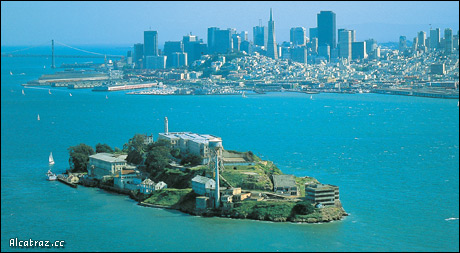
Alcatraz Island Photo �San Francisco Visitors & Convention Bureau
|
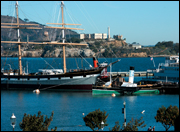
Hyde Street Pier
|
ALCATRAZ ISLAND has served as a harbor fortification, military detention facility and maximum-security federal penitentiary. The West Coast’s first and oldest operating lighthouse is also located on Alcatraz. Today Alcatraz is one of San Francisco’s top tour attractions that often sells out. Over one million people visit Alcatraz each year. Only 1.25 miles from downtown San Francisco, yet isolated by harsh weather and rough waters, Alcatraz Island's unique geography has made it prized real estate throughout its long history.
|
ALCATRAZ THE PENITENTIARY |
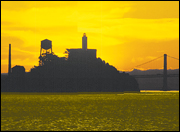
Morning sunrise
|
Most curiosity surrounding Alcatraz focuses on the period when the island served as the infamous maximum-security prison for notorious Mafia criminals and high-risk convicts. In 1934 control of Alcatraz shifted from the US military to the Department of Justice who found itself ill equipped to deal with the violent crime surge that followed the Great Depression. Citizens lived in fear as mobsters and thugs ruled the streets in many metropolitan cities. Alcatraz proved the perfect solution for incarcerating the most violent of criminals.
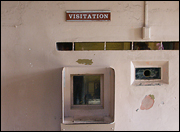
Visiting area
|
A foremost security expert was commissioned to design a 600-cell escape-proof prison. Security measures included installation of tool-proof bars and cementing in utility tunnels to eliminate possible escape routes. Special gun galleries gave guards protection and metal detectors, utilizing a new technology, were installed outside the dining hall and other strategic locations. A ratio of one guard to every three prisoners was maintained at Alcatraz prison. |
| If the icy and treacherous waters of the bay weren’t enough to deter prisoners from contemplating an Alcatraz escape, the location of the prison served a dual purpose of frightening citizens from contemplating a life of crime. |
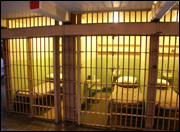
Typical cell
|
The first warden appointed, a strict disciplinarian, was James A. Johnston. The first prisoners on Alcatraz were handpicked from other penitentiaries and were among the nation’s most unmanageable convicts. Al Capone, Machine Gun Kelly and Robert “Birdman” Stroud were among the first group of inmates to arrive. Crimes committed by the hardened criminals who resided on the island ranged from bank robbery to rape to murder. |
PRISON LIFE
|
| Upon arrival at Alcatraz new prisoners were assigned to a private cell and provided with only life’s most basic necessities: clothing, food, water and medical care; anything above and beyond this was considered a privilege. |
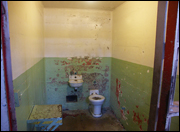
Holding cell
|
Under Warden Johnston inmates were required to observe a strict silence policy, only being allowed to talk during meals and recreation. Scooping water from the toilets created a primitive voice pipe in which inmates could whisper to each other from cell to cell. Visitation rights had to be earned and all visitors had to be approved by the warden. Sending and receiving letters was also a privilege (all letters were censored by prison officials). Even work was a privilege with assignments tied to conduct records. As quickly as privileges were earned they could be revoked for even the slightest infraction of the rules. |
| A highly regimented schedule meant prisoners were woken at 6:30am, cleaned their cells and marched single file down the main corridor in silence to the mess hall for breakfast. Historically, many prison riots had been started because of the poor quality of prison food so Warden Johnston vowed that the Alcatraz cafeteria would be the best in the prison system. Prisoners of Alcatraz dined on a menu of salads, fresh fruit, diverse entrees and even desserts. Following breakfast, the prisoners were then given their work assignments for the day. |
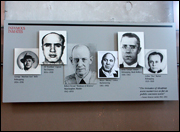
Al Capone, Birdman & others
|
AL CAPONE: ALCATRAZ’S MOST INFAMOUS PRISONER
When Al Capone arrived on Alcatraz in 1934 prison officials made it clear that he would not be receiving any preferential treatment. While serving his time in Atlanta, Capone, a master manipulator, had continued running his rackets from behind bars by buying off guards. “Big Al” generated incredible media attention while on Alcatraz though he served just four and a half years of his sentence there before developing symptoms of syphilis and being transferred to a prison in Southern California where he died. |
ESCAPE FROM ALCATRAZ
|
There were 14 attempts to escape Alcatraz during its 29-year tenure as a federal penitentiary. Most attempts ended with escapees being recaptured or killed. Although the island is only a mile from shore, there is no evidence of any successful escapes across the icy bay. The prison was the only one in the federal system that touted hot showers�a luxury designed to keep prisoners from acclimating to cold water. It was a myth that there are man-eating sharks in the San Francisco bay.
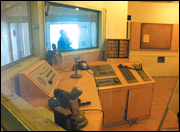
Guard control station
|
The first of two famous escape attempts occurred in 1946 and involved an inmate who devised a makeshift bar spreader that enabled him to escape from his cell, break into a gun gallery, overpower a guard and arm his accomplices with weapons. When the inmates’ efforts to storm out of the prison with firepower failed, they took several guards hostage. The warden called in the Marines, Navy and Coast Guard to assist in regaining order. Fighting lasted two days and left two officers and the inmates behind the escape dead. |
| Frank Lee Morris and Clarence and John Anglin made the most famous escape attempt in 1962. The movie, “Escape from Alcatraz,” starring Clint Eastwood, was based on their elaborate plot. Over a period of six months the inmates used tools they’d stolen from prison job sites to chip away at the vents in their cells. As part of the elaborate plan the team fabricated large grill covers to conceal their work from guards as well as lifelike dummies so they wouldn’t be missed from their beds during the prisoner counts. Once free of their cells they’d make their way off the island using rafts and inflatable life vests made from prison issued raincoats. |
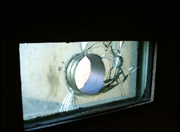
Gun portal for guards
|
Following a morning prisoner count, two of the three inmates were able to squeeze though the widened vents. Morris and the Anglins made their way up the ventilation duct to the roof (where they’d earlier spread apart bars), scaled down the prison wall along drainpipes and finally climbed over the 15-foot fence. After running to the water, it’s believed they inflated their rafts and life vests and escaped. The FBI would later rule their attempt unsuccessful, though many still speculate whether or not the inmates survived the icy Bay waters to reach land. |
HENRY YOUNG & ALCATRAZ SOLITARY CONFINEMENT
|
| Henry “Henri” Young, a convicted bank robber and murder, was transferred to Alcatraz for instigating fights with fellow prisoners. While on Alcatraz, Young and an accomplice, Rufus McCain, tried to escape. The failed attempt resulted in the death of the infamous gangster Doc Barker and landed the pair in solitary confinement for nearly two years. |
| After returning to the general prison population, Young stabbed and killed McCain. During Young's trial, his attorney claimed that Young had gone crazy due to the length of time he’d spent in solitary. He equated the extended stay to “cruel and unusual punishment” and argued that Young should not be held responsible for his actions. |
Warden Johnson and several inmates were subpoenaed to testify on prison conditions and procedures. After several inmates recounted second-hand tales of beatings and the psychological effects of imprisonment, the jury sympathized with Young and he was convicted of manslaughter. The verdict added only a few years to his sentence.
|
ALCATRAZ CLOSES
|
In 1963 the decision to close Alcatraz was made by US Attorney General Robert Kennedy. Alcatraz desperately needed repair from extensive salt-water and air corrosion at a time when budgets were being cut. At three times the operating expenses of other penitentiaries, Alcatraz was simply too costly to keep open. The isolation (and hence lack of natural resources) that had made the island such an attractive site for a maximum-security prison ultimately sealed its fate.
|
ALCATRAZ HISTORY TIMELINE
|
| A visit to Alcatraz offers a fascinating history lesson that spans from the Civil War to post-Depression America to the passionate political activism of the late 60s. |
|
1542 - Spain makes claim to the land known as Alta California.
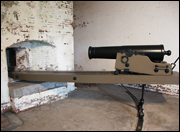
US Army cannon
|
1769 - Spanish explorers “discover” Alcatraz Island, probably in error, miscalculating a voyage to Monterey.
1775 - Juan Manuel de Ayala names the island “Isla de los Alcatraces” (Island of the Pelicans). Solders of US Army later nickname it “The Rock”.
1822 - Mexican Republic granted independence and with it claim to the small island.
1846 � Private Mexican citizen receives land grant for Alcatraz from Mexican Republic with condition that navigation light is established on the island.
1848 - Mexican-American War ends; US claims control of California.
1848 - United States refuses to recognize any private ownership claims to Alcatraz. Since no lighthouse was built under Mexican land grant, all claims considered null and void. Alcatraz deemed public land, property of the United States Government.
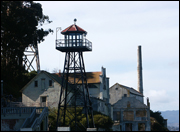
Watchtower
|
1849 - Gold Rush begins with discovery of gold in the American River. San Francisco grows to population of 35,000. With discovery of gold and population explosion, need for West Coast harbor defense grows in importance.
1850 - President Millard Fillmore earmarks Alcatraz and other land in and around the bay for harbor defenses.
1851- Board of Engineers for the Pacific Coast established to oversee construction of major harbor forts. Original estimate for construction of fortress on Alcatraz Island was a conservative $300,000 (actual cost through 1869 - $1,600,000).
1854 - After two years of construction, first lighthouse on Alcatraz (and the West Coast) lit with whale oil. Prior to completion several vessels sank in the Bay.
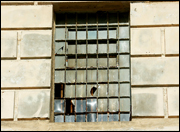
Alcatraz prisoner window
|
1859 - Company H of the Third U.S. Artillery, lead by Capt. Joseph Stewart, take command of Alcatraz. Biggest guns on Alcatraz were 60,000-pound cast iron, 15-inch Rodmans with a 3-mile range. At a high point 433 men were assigned to Alcatraz.
1861 - Civil War begins, Alcatraz military forces ordered on high alert. Any ship flying confederate flag ordered captured or sunk.
1863 - US Navy foils elaborate plan by Confederate sympathizers aboard the schooner J.M. Chapman and imprisons crew on Alcatraz.
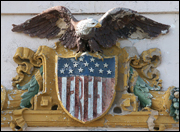
Indians painted FREE
|
1865 - Civil war ends, President Lincoln assassinated, Alcatraz soldiers sent to San Francisco to help keep order.
1868 - Plans begin for complete redesign of Alcatraz reflecting nationwide standardization of battery design.
1870 �1876 - With little more than initial excavation by prison laborers completed, Congress cuts off appropriations for building national fortifications. Role of Alcatraz shifts from harbor defense to military prison.
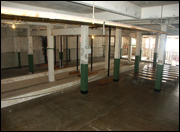
Shower area
|
1895 - Nineteen members of the Hopi tribe imprisoned on Alcatraz.
1899 - Following Spanish-American War, US Military recognizes need for modern prison facility on the West Coast. Prison population on Alcatraz grows to 441, overcrowding current structures.
1906 � Earthquake hits San Francisco, municipal prison damaged, prisoners transferred to Alcatraz.
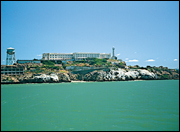
Alcatraz prison
|
1907 - War Department determines Alcatraz obsolete as harbor-defense fort and designates it a permanent prison to serves the entire United States Army west of the Rockies. Renamed “Pacific Branch US Military Prison, Alcatraz Island”.
1908 � New 84-foot concrete lighthouse tower constructed.
1909 - $250,000 approved for construction of the world’s largest concrete cell house. Plan calls for 600 one-man cells within a 500 foot-long structure to be built by convict laborers.
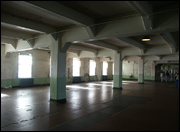
Mess hall
|
1912 - New prison facility is completed.
1915 - Alcatraz renamed “Pacific Branch, United States Disciplinary Barracks”. New name reflects an emphasis on rehabilitation as well as punishment.
1930 - Great depression and surge in organized crime leads to military budget review of disciplinary barracks and search for new maximum security prison to house the nation’s most incorrigible prisoners.
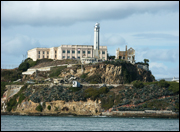
Alcatraz Island from city
|
1934 - Alcatraz acquired by Department of Justice and transformed into a United States Penitentiary. Military abandons Alcatraz, leaving behind 32 hard case prisoners, who were to become the first penitentiary inmates.
1934 - Al Capone, Machine Gun Kelly and Robert “Birdman” Stroud arrive on Alcatraz.
1938 - Al Capone transferred from Alcatraz due to illness.
1962 � Elaborate escape attempt made by Frank Lee Morris, Clarence and John Anglin.
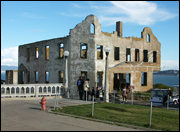
Wardens home after fire
|
1963 - Alcatraz penitentiary closes.
1969 � Large group of Native Americans land on Alcatraz and claim the island as Indian property.
1970 � During Indian occupation, fire destroys Wardens house, officers club and damages historic lighthouse.
1971 � Federal Marshals descend on Alcatraz and arrest final Native American occupants for destruction of US property.
1972 - Congress creates the Golden Gate National Recreation Area that includes Alcatraz.
1973 - Alcatraz Island opens to the public; over one million people visit the National Park each year.
|
TAKING AN ALCATRAZ TOUR/BUYING AN ALCATRAZ TICKET
|
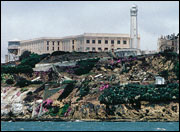
Alcatraz Island
|
The National Park Service administers Alcatraz Island as part of the Golden Gate National Recreation Area (GGNRA). The 22-acre island is accessible only by the Alcatraz Cruises ferry that departs daily from Pier 33, Hornblower Alcatraz Landing near Fisherman’s Wharf. Several tour companies offer tickets to Alcatraz but currently all resellers must package Alcatraz tickets with another tour when selling Alcatraz tickets. Individuals purchasing tickets from street vendors or sources other than Alcatraz Cruises, LCC do so at their own risk. |
| Hours of operation on the island vary with the season, ferry departures from Pier 41 are available throughout the day beginning at 9:30am (the early bird tour which is the least crowded) and running about every 30 to 45 minutes. During the summer, the island closes at 6:30pm and at 4:30pm in fall, winter and spring. Christmas and New Year’s Day are the only holidays that Alcatraz is closed, or due to extreme weather. Planning your Alcatraz visit � to avoid disappointment, advance Alcatraz ferry ticket sales are strongly recommended. In summer months and on holiday weekends, Alcatraz sells out as early as a week to 10 days in advance. |
| On September 25, 2006 Alcatraz Cruises, LLC became the official vendor and transportation provider for Alcatraz tickets. Tickets are sold on a first come first served basis by walking up to the ticket booth on the day of the tour, online at www.alcatrazcruises.com, or by calling (415) 981-7625. Note that if you are purchasing Alcatraz tickets from any other online vendor you are likely paying a substantial service charge for them to book your tickets for you through Alcatraz Cruises. |
Alcatraz Ferry � The value of one adult Alcatraz ticket with audio tour when purchased through Alcatraz Cruises is $21.75. There is no discount Alcatraz coupon available for the ferry/walking tour ticket purchased through Alcatraz Cruises. Discount coupons may be available for Alcatraz tour packages from sites like GuideYou.com. Plan to spend approximately 2 1/2 hours to tour the cell house and island.
|
ALCATRAZ TOUR SAN FRANCISCO
FARE AND DEPARTURE INFORMATION
|
Fares-Round Trip:
|
Adult (18-61)
Early Bird..... $24.50
Day Tour...... $24.50
Night Tour*..... $31.50 |
Junior (12-17)
Early Bird..... $24.50
Day Tour...... $24.50
Night Tour*..... $30.50 |
Child (5-11)
Early Bird..... $15.25
Day Tour...... $15.25
Night Tour*..... $18.75 |
Senior (62+)
Early Bird..... $23.25
Day Tour...... $23.25
Night Tour*..... $29.25 |
Toddlers (0-4)
Early Bird..... Free
Day Tour...... Free
Night Tour*..... Free |
Family (2 Adults + 2 Children)
Early Bird..... $74.50
Day Tour...... $74.50
Night Tour*..... not available |
|
Award-winning, self-guided audio tour of the cell house
*Night Tour will resume operation in April 2008
|
Schedule / Daily Departures:
|
| 9:00am (early bird); |
| 9:30am; |
10:00am; |
10:30am; |
11:00am; |
| 11:35am; |
12:10pm; |
12:45pm; |
1:20pm; |
1:55pm;
|
|
|
4:30pm (night tour*);
|
|
| Return Times |
| 10:00am; |
| 10:30am; |
11:00am; |
11:30am; |
12:05am; |
| 12:40am; |
1:15pm; |
1:50pm; |
2:25pm; |
3:10pm;
|
3:45pm
|
4:30pm
|
|
7:15pm (night tour*);
|
(allow 15 minutes to return to Pier 33
after departure from Alcatraz) |
|
No service Christmas and New Year's Day. Night tour is closed Christmas Eve and New Year's Eve. Schedule subject to change. Reserve your ticket for Alcatraz, San Francisco's most popular attraction, in advance!
|
| GuideYou.com does not sell tickets to Alcatraz, but offers tickets to almost every other San Francisco attraction. Bay City Guide has negotiated special discounted ticket rates with its advertisers, sold only online. Deluxe San Francisco City Tour, 1 Hour Bay Cruise, Wine Country Tour & Tasting, Muir Woods & Sausalito and more, all available on GuideYou.com. |
|
SIGHTSEEING ALCATRAZ: AUDIO TOUR / SELF GUIDED TOUR |
| An award-winning 35-minute audio tour of the prison cell house with actual interviews of former guards and inmates is available in six languages. |
| The National Park Service presents a 14-minute video program on the Island’s 200-year history. The presentation is offered in the Island’s theater and is captioned for hearing impaired visitors. Several exhibits present the various periods of Alcatraz’s history, from early military history to the Island’s occupation by Indians from 1969-1971. |
A self-guide Alcatraz Island Tour brochure (printed in English, Italian, Spanish, German or Japanese) is available at the dock for a fee.
|
ACCESS |
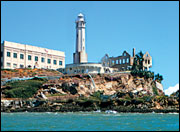
Alcatraz is picture perfect!
|
To reach the cell house visitors must walk up a steep hill. The distance from the dock to the cell house is approximately 1/4 mile and equivalent to a 13-story climb. Visitors unable to make this climb due to any mobility limitations may take advantage of an hourly electric shuttle that leaves from the ferry dock at 40 minutes past each hour. For visitors with hearing impairments, written transcripts of the cell house tour are available at the dock office and video programs are close-captioned.
|
ALCATRAZ NIGHT TOUR (SEASONAL) |
The Alcatraz Night Tour is a unique program that began in 1997 and is limited to just a few hundred visitors per evening. Aside from the spectacular sunset and skyline views, the evening tours differ from the daytime visits in a number of ways including a guided tour, special programs and activities and a keepsake souvenir. Note: access to certain sections of the island open during the day is not available to the public at night. Alcatraz Night Tour schedule: tours available seasonally, Thurs. -Mon. at 4:20pm and 5:10pm
|
AGAVE TRAIL |
Breathtaking views of San Francisco and the Golden Gate can be captured from the beautifully landscaped Agave Trail. The trail (open from late September to mid-February) begins near the ferryboat landing on the east side of the island and winds through a protected bird sanctuary to a stone stairway where prison guards’ houses once stood.
|
ALCATRAZ INFORMATION LINKS |
AlcatrazCruises.com
An Alcatraz ferry ticket is also available for purchase at the Alcatraz Cruises ticket booth located at Pier 33, the Hornblower Alcatraz Landing or by calling (415) 981-7625. |
BayCityGuide.com
San Francisco’s #1 visitor guide ��Alcatraz San Francisco Information
|
GuideYou.com
San Francisco discount tour and attraction tickets.
|
www.nps.gov/alcatraz
Official National Park Service information
|
www.csulb.edu/~gcampus/libarts/am-indian/alcatraz/
Indian occupation of Alcatraz
|
www.bop.gov/ipapg/ipaalcarule.html
Alcatraz: Inmate Regulations |
alcatrazhistory.com
Comprehensive Alcatraz history |
|
RentalGuide.com
Vacation rentals and hotel alternatives. Online database.
|
SOURCES |
Fortress Alcatraz, John Arturo Martini
|
National Park Service
|
Alcatraz - A Definitive History of the Penitentiary Years, Michael Esslinger
|
BOOKS |
| Alcatraz: A Definitive History of the Penitentiary Years |
| Birdman : The Many Faces of Robert Stroud |
| Alcatraz from Inside: The Hard Years 1942-1952 |
| Birdman of Alcatraz: The Story of Robert Stroud |
| Riddle of the Rock: The Only Successful Escape from Alcatraz |
| Eyewitness on Alcatraz: Life on the Rock As Told by the Guards, Families and Prisoners |
| Breaking the Rock: The Great Escape from Alcatraz |
| Inside the Walls of Alcatraz |
| Alcatraz Screw: My Years As a Guard in America's Most Notorious Prison |
| Like a Hurricane: The Indian Movement from Alcatraz to Wounded Knee |
| Last Train To Alcatraz; The Autobiography of Leon (Whitey) Thompson (Former Alcatraz Inmate) |
| Alcatraz (Building History Series) |
| The Occupation of Alcatraz Island: Indian Self-Determination and the Rise of Indian Activism |
|
Fortress Alcatraz: Guardian of the Golden Gate
|
| American Indian Activism: Alcatraz to the Longest Walk |
| Heart of the Rock: The Indian Invasion of Alcatraz |
DVDs |
|
Escape from Alcatraz
|
| Birdman of Alcatraz |
| The Rock |

Alcatraz Photo Credit: Drew Patterson.
You may use the images on this page after reading and complying with the following license agreement: Creative Commons License.
Please read our terms for Alcatraz.cc picture usage.
|


